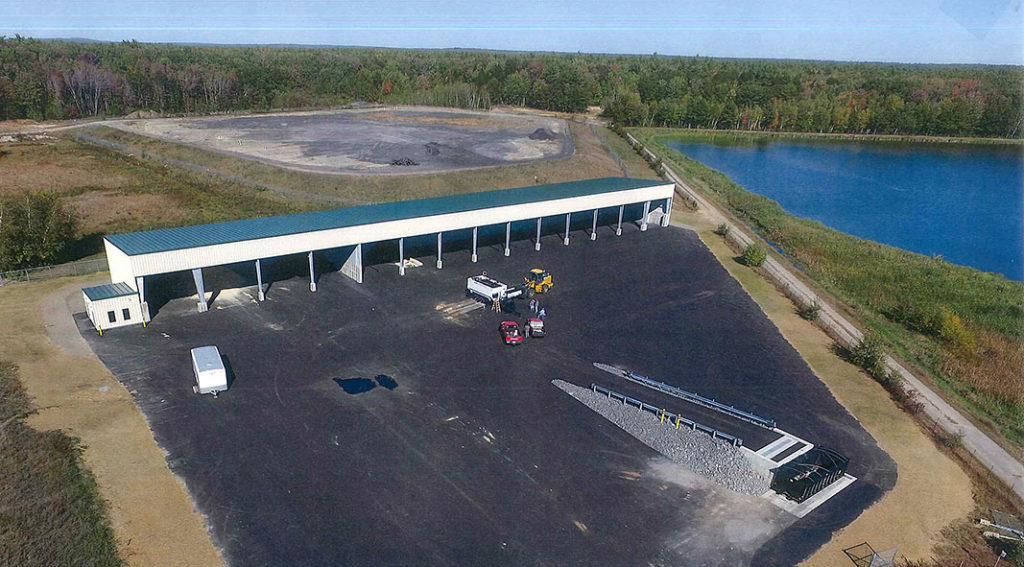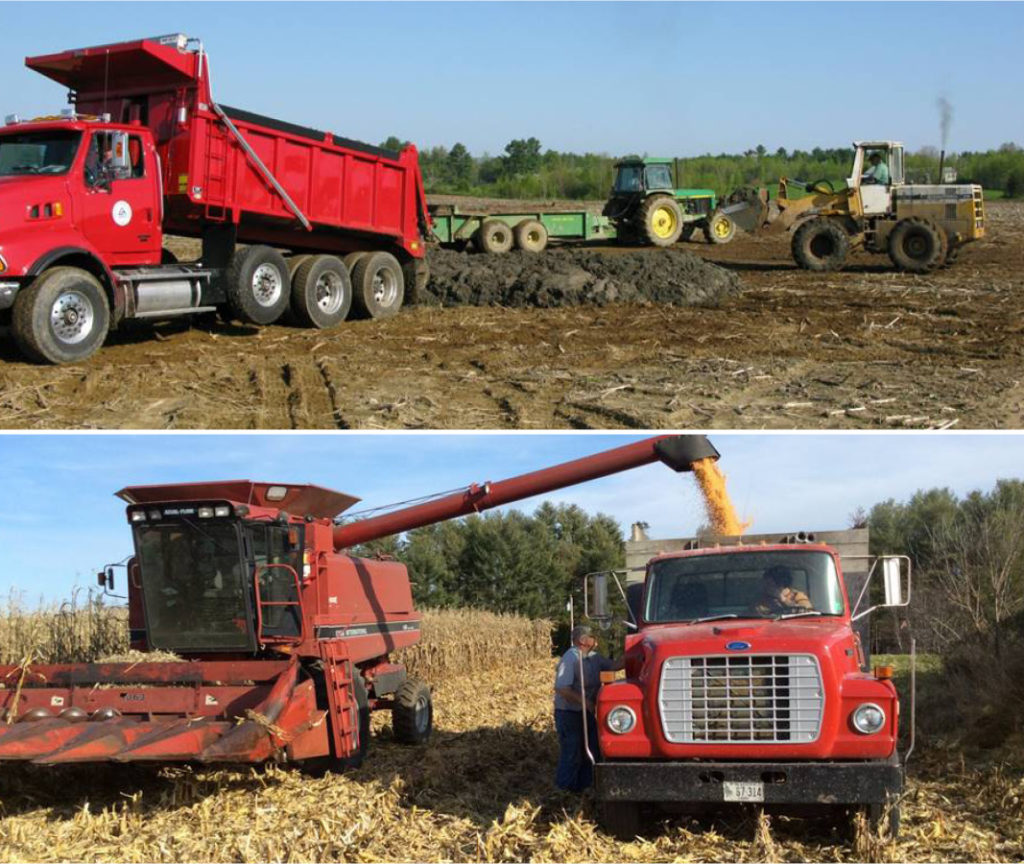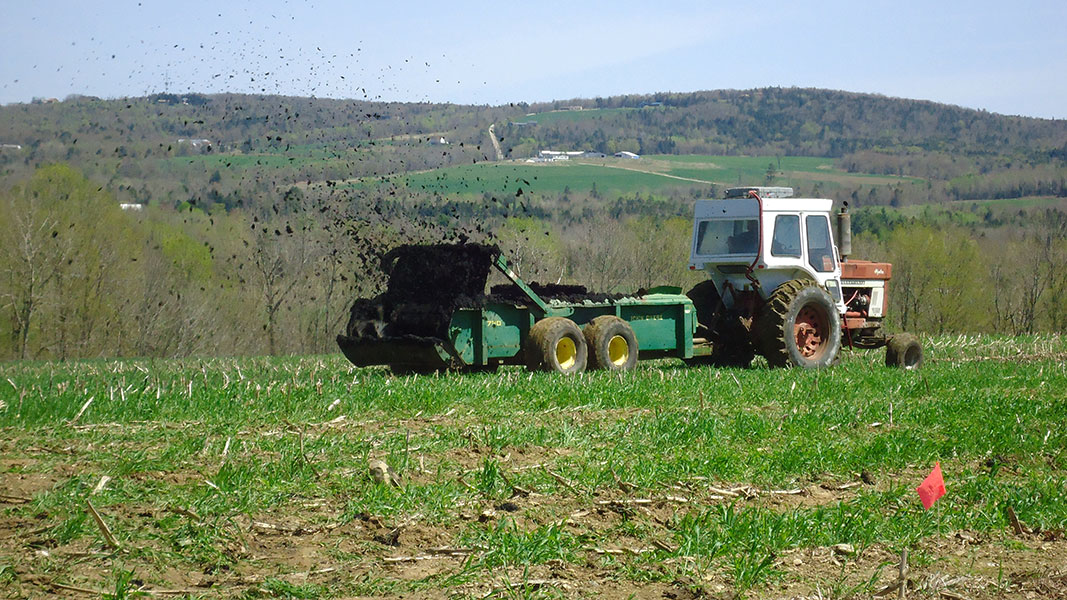Top: Class B biosolids application on farmland in Maine. Photo courtesy of Casella Waste Systems, Inc.
 Sally Brown
Sally Brown
Maine has been the epicenter of much of the concern about PFAS — perfluorinated organic compounds — in biosolids and composts. The state recently banned beneficial use of biosolids land application and/or recycling of biosolids as a soil amendment. This applies to biosolids compost as well, and was the result of a legislative bill (L.D. 1911) that overwhelmingly passed both the state Senate and House in April 2022 and was signed into law by the governor. This ban may be used as a model for composting and biosolids programs in other states as well. To get a sense of the situation in Maine, I asked Andrew Carpenter of Northern Tilth in Belfast, Maine, a long-time friend and colleague who has worked extensively in organic waste recycling projects in New England and whose business now includes sampling soils and other environmental media for legacy PFAS contamination.
Painting The PFAS Picture
Editor’s Note: This interview references Class A and Class B biosolids designations established under the federal rule, 40 CFR Part 503, based on treatment methods. The different classes have specified treatment requirements for pollutants, pathogens and vector attraction reduction, as well as general requirements and management practices. 40 CFR Part 503 treatment processes for Class A biosolids eliminate pathogens, including viruses. Generally, pathogens may exist when requirements are met under 40 CFR Part 503 for Class B biosolids, which is why EPA’s site restrictions that allow time for pathogen degradation should be followed for harvesting crops and turf, for grazing of animals, and public contact.
Brown: What was the state of biosolids in Maine prior to PFAS coming up on the radar?
Carpenter: Historically, Maine has had one of the highest biosolids recycling rates in New England, and typically higher than the national average. In the past, about 75% of biosolids generated in the state have been recycled, either through Class B land application programs or Class A general distribution programs (after composting or advanced alkaline stabilization). From the late 1990s through the early 2000s, there was a trend from Class B to Class A stabilization, and slightly increasing landfilling rates over time.
Brown: What proportion of what is produced is Class A vs. Class B?
Carpenter: Prior to the ban, I believe of the biosolids recycled in Maine, it was about 6 to 1, Class A vs. Class B (on a wet weight basis).
Brown: Of the Class A material, how much is used by homeowners? What are other uses of Class A biosolids?
Carpenter: I do not know. There were bulk agricultural land application programs and a significant amount of the compost went to horticultural and topsoil manufacturing programs.

The Sanford Sewerage District’s (SSD) biosolids composting facility opened in 2016. Photo courtesy of SSD
Brown: How did PFAS hit the radar?
Carpenter: In 2016, there was a federal program investigating unregulated drinking water contaminants in drinking water supplies across the U.S. A test well that was either on or adjacent to a farm field for a water district in southern Maine that was participating in this program had some hits for PFAS. Follow up testing at the farm found high PFAS soil levels (up to 800 ug/kg, or parts per billion, PFOS) and also relatively high levels in milk, grass and manure at the farm. The farm had a history of residuals use, and it seemed possible that the PFAS on the farm may have come from residuals used as soil amendments. In 2019, the Maine Department of Environmental Protection (ME DEP) started requiring testing for PFAS in all biosolids land application programs.
Brown: You have seen some sites with extremely high PFAS concentrations. Can you talk about those sites?
Carpenter: There are at least seven farms (and likely more as I do not know of all of the testing results in the state) on which very high levels of PFAS have been found in either soil, irrigation water and/or farm products. In addition, drinking water at scores of residential wells in the vicinity of some of these farms have very high levels (greater than 1,000 ng/L or parts/trillion (ppt)). The situation at each farm is different, e.g., they range from conventional dairies, to organic dairies, to vegetable operations and diversified farms. They all do have a history of land application of biosolids. For the organic operations, the applications were typically by a former landowner.
Identifying PFAS Sources
Brown: What are the cumulative loading and approximate estimated biosolids concentrations?
Carpenter: Based on comprehensive testing of all biosolids, biosolids and septage-based composts, and paper mill residuals in Maine, it is clear that contemporary levels of the 28 PFAS compounds for which most commercial labs are currently testing are much lower than they were in the past. It also seems clear that at least one source of Maine municipal biosolids was what would be considered industrially contaminated in the past (from what we can tell in the late 1980s and early 1990s). Because there are records of amounts of biosolids that have been applied historically in Maine, it is possible to run rough calculations of what the levels in the “hot” biosolids would have been in the past. On one of the farms with very high levels of PFAS in the soil, it appears that the biosolids would have had a level of PFOS (one of the PFAS compounds with an eight-carbon structure) in the ballpark of 7,000 to 10,000 parts/billion (ppb, dry weight) in the early 1990s. Contemporary levels for PFOS in typical biosolids are about three orders of magnitude lower than those estimated levels.
Brown: Are there clear sources of the PFAS’ origins? Does this suggest limited sites of high contamination?
Carpenter: We have been directly involved in much of the PFAS testing on farms in Maine in the past three years. From my perspective there is enough evidence to indicate that contaminated biosolids and/or other residuals (organic matter-based soil amendments) are likely the main source (if not the only one) on several of the farms at which high levels have been found in soil, water and/or farm products. As I mentioned above, based on relating land application records to soil levels, it appears that there was at least one source of biosolids that had very high PFAS levels. I do not believe the mystery is solved; it is possible that there are other sources of residuals that have not been as clearly identified that have caused higher than expected levels at some farms. There are also other sources of PFAS contamination in Maine, most notably at some of Maine’s Department of Defense sites. Because PFAS compounds have been so widely used in commercial products, I think it is possible that as we complete more testing, we may find other sources of contributions to farms.
Brown: What are the exposure pathways of concern with PFAS contamination?
Carpenter: There have been several potential pathways of concern relative to high levels of PFAS on agricultural fields. These include:
- Soil—groundwater
- Soil—hay—cow—beef
- Soil—hay—cow—milk
- Irrigation water—vegetables
Based on research by the Maine Center for Disease Control and Prevention (Maine CDC) and based on existing published literature, it seems clear that grass and leafy greens are the greatest concern for crops in Maine taking up PFAS from contaminated soils. Grains (corn, beans, etc.) and fruiting vegetables appear to have much lower transfer factors from soil into the edible portion of the crop. There are some other less clear pathways that are more likely on highly contaminated sites — such as the pathway of soil—hay—cow—manure—soil on other fields — that did not originally have elevated levels.

Staging for land application of biosolids on agricultural fields (top), and harvesting of corn grown on those fields. Photos courtesy of NEBRA
Degrees Of Contamination, Next Steps
Brown: With your involvement in sampling, how would you categorize the types of sites that you’ve seen?
Carpenter: Three categories:
- Highly contaminated sites at which soils can be in the 100s of ppb for PFOS and/or PFOA and which have resulted in very highly contaminated drinking water wells, irrigation water wells, grass and farm products, including milk.
- Long term land application sites, which have not received what would be considered industrially contaminated biosolids but show evidence of historical levels of PFAS that are higher than what we see in contemporary biosolids. These typically have not been associated with the high levels of contamination in drinking water and/or farm products, but with newer guidance on the toxicity levels of PFAS these could be a concern in the future.
- Agricultural fields that have received limited amounts of residuals in the past decade which have PFAS levels in the range of what we see as background levels for PFOS and PFOA (less than 1 ppb).
Brown: With the extreme contamination, do you have a sense if this has resulted in elevated PFAS in non-treated soils?

A turf application of biosolids compost produced by the Town of Sanford (ME) Sewerage District’s municipal facility. Photo courtesy of SSD
Carpenter: As mentioned above, there are some sites at which it appears that heavily contaminated agricultural soils have resulted in higher manure levels which can then impact non-treated soils when that manure is applied. This seems to be relatively rare.
Brown: What are your predictions on the future?
Carpenter: Hard to say. I know that in Maine, this issue has led to consumers demanding to know that farm products and soil amendments they purchase are PFAS-free. This is not always possible, regardless of whether a source of PFAS has been introduced to a farm or composting facility, because PFAS compounds are so ubiquitous. I predict that this will be an issue that the agricultural world will be dealing with for several more years.
Brown: What would you recommend?
Carpenter: There are several important steps to take:
- For biosolids, test materials regularly for PFAS, and if levels are elevated, investigate upstream immediately to find and eliminate point sources to water resource recovery facilities (WRRFs).
- Get a better handle on the prevalence of other PFAS compounds for which we are not currently testing and determining their toxicity, fate and transport and responding accordingly.
- Eliminate the use of those PFAS compounds that are prevalent and have mobility in the environment and potential toxicity to farm animals, wildlife and humans.
Also, we need to recognize that prior to our knowledge of the prevalence and physiochemical properties of PFAS in the environment, most of the organic contaminants found regularly in biosolids were either short-lived in the soil environment (easily metabolized by soil microbes or otherwise attenuated) or were strongly sorbed to soil and/or soil organic matter and as such were not a significant threat to groundwater and/or crop uptake. Many of the PFAS compounds are both resistant to degradation, but also have some mobility, which makes them more of an environmental concern. For this reason, I also think it is important to determine if there are other organic compounds that may occur in biosolids that have physiochemical properties similar to PFAS.
Sally Brown, BioCycle Senior Adviser, is a Research Professor at the University of Washington in the College of the Environment.













